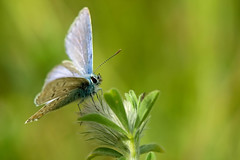As beautiful as they are fragile, butterflies are one of my favorite subjects to shoot –and one of the most difficult to get close to in the wild. I’m often asked how I get so close to them and here is what I’ve learned.
Shoot them when they are distracted.
Like all insects, butterflies are more likely to stay put if they are occupied. Go looking for them early in the morning when they are trying to dry out from the previous night’s dew and feeding. In the heat of the day they are very active and less likely to let you get close. Although I’ve never encountered a mating pair, if they are anything like dragonflies then you should be able to get close if you find a couple coupled ;)
Don’t act like a snake.
Predators, like snakes and lizards, move slowly when they are trying to get close to a victim and then speed up for the kill. If you get excited and speed up as you are getting close to a butterfly then you are simply mimicking the motion of a predator. Keep you movements even and slow…
Picture the image in your mind.
Know what image you want before you get into position and compose for it as you are getting close. Often a butterfly will only give me one or two frames before taking off so I have to picture the image in my head and position myself to get it –I won’t get the chance to recompose. If you have access to a butterfly sanctuary then go there and practice composition. If I had access to one I think my initial success rate would have been higher since I’d have a better understand of how to compose my shots.
Cast no shadow.
Butterflies are on just about every back yard predator’s buffet table and are hard wired to react to changes in light. If your shadow falls over a butterfly then you can forget about shooting it. Even flash photography can be a problem since butterflies perceive any change in light as movement. Most modern flashes produce a small pre-flash burst of light that the camera uses for metering, and butterflies are so fast that they can jump as the shutter is opening. If you find that you’re taking a lot of “action shots” of blurry, jumping butterflies then turn off your flash.
Use the focus ring.
One last tip that I, as a macro shooter, take for granted. Butterflies are also sensitive to vibration so you may have to turn off the auto focus on your lens and do it “old school”. Part of my success getting within inches of wild butterflies is probably due to the fact that I’ve almost worn out the focus ring on my 100mm macro lens.
Good hunting and good luck! ;)


4 comments:
very nice blog - excellent work ;)
Thanks! I need to post a little more often -just too much Real Life(TM) getting in the way lately ;)
Butterflies have always been difficult for me to photograph. I've gotten lucky a few times but with this excellent advice perhaps it will eventually become easier for me. Thanks!!
Please let me know how it turns out Linda!
Post a Comment